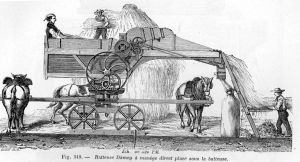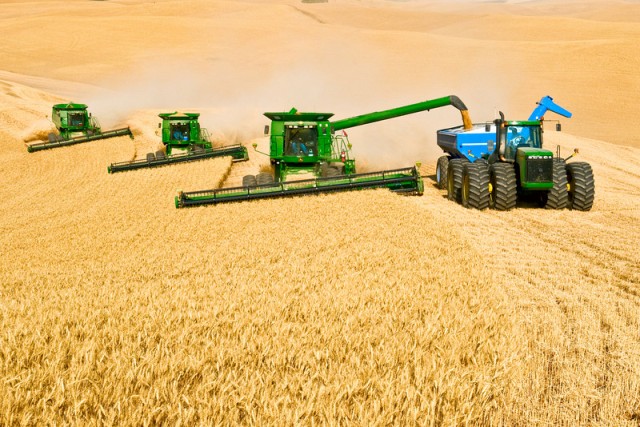In keeping with my “pro-robot” (pro-automation) posts I thought I’d stick up some photos.

Cutting wheat by hand. This is step one. After it’s cut you must dry it and then separate the wheat from the stalk; a process called threshing.
What do you see? I see five women in funny hats that are working their ass off. They will all have a sore back tomorrow morning.
What do you see? I see three guys and three horses all working like dogs. (I also see gears and pulleys that look like they’d rip an arm off in a heartbeat… but that’s another topic.)
What do you see? I see four people working in air conditioned cabs… assisted by a massive amount of technology.
This is where one faces the classic is the glass “half full” or “half empty” paradox.
If you’re down in close to the action it is possible to look at the first two photos and the last one and see eight jobs turning to three. What a nightmare! “What will happen to those poor people who no longer have their delightful peasant occupation? Also what about the horses? Who will care for the horses!”
From a distance I’m pretty sure that most people who once had to harvest wheat by hand very much preferred doing something else. The Amish and a few hippies aside… hand harvesting is hard, dirty, hot, backbreaking labor. Machines have improved our lives.
Remember that when the labor rate goes high enough to put a bunch of McDonalds employees out of work and politicians blovate about how that’s a bad thing and if you vote for them they’ll “fix” it. It’s only a bad thing if the only thing you think those folks are good for is flipping burgers. I tend to think most people, given the choice, might be capable of a whole lot more.



Even the Amish use mechanical means. These whiners must never baled hay on a 100 degree day. Don’t know the actual physical meaning of the word drudgery.
Picture 3: what productive American’s are doing.
Picture 2: what politicians and the urban elites think Americans are doing.
Picture 1: what we should have the politicians and urban elites doing for 6 and half days a week. Then they can tell us what we should be doing with our lives if they have the energy.
Ha ha ha!
Amen, brother. I’ve bucked bales (briefly) and swung a scythe (again, briefly). Machines good. Back bad.
Eight jobs didn’t turn to three – they just changed professions. After all,someone has to build those combines. Not to mention hunt for fossil fuels and get it out of the ground and refine it. And a whole bunch of other stuff.
But you make a good point. We could eliminate unemployment by fiat – just forbid the use of internal combustion on the farm and half of us would be once again toiling in the fields. In fact I suggest that the government invest in some farm land and use every man and woman on unemployment to work it the old fashioned way. My guess is that this would pretty much eliminate unemployment.
This is something that bothers me about the Commie emblem, never mind the ideology behind it.
If the sickle is your symbol of agriculture… you’re relying on an endless supply of expendable peasants.
Stoop labor. Feh. See also the short-handled hoe, and Cesar Chavez.
Can we hurry up and invent robot politicians? They should be made light and compact enough to mount on the back of those harvesters, so as to fertilise the soil for the next crop.
We don’t have robot politicans but some seem like clones.
Your first pic, I count six. Doesn’t ruin your argument though.
That’s ok, in my last photo there are four machines and somehow I wrote three workers. Apparently my quality control department is slacking. I’ll give myself a stern talking to. 🙂
In the last photo, where is the grain going from the combine harvesters #2 and #3?
The machines have an inner hopper that stores processed grains. As the machine harvests its way across the field, processed grains accumulate in internal storage. Excess materials, chaff, straw, etc… are spewed out the back.
The unloading process is independent of harvesting process. The operator can always stop a fully laden harvester next to a parked truck, swivel around the auger, and spew the finished product into the truck while stationary. You’ll sometimes see a truck driver and the harvester driver standing around talking next to a harvester loudly blowing mountains of grain into a parked truck.
In other words, when you see the truck and the harvester rolling along next to each other in a field it’s a sign that neither party is willing to waste time standing around chatting. They’re making bank and refuse to let up even a single minute for a stationary offload. Harvesting and offloading simultaneously from dual moving machines is bad ass!
I should also mention that they have lights and can run in the dark but I think there are technicaly limitations related to increased relative humidity in the evening. Otherwise they’d probably drive 24/7 until they turned into complete zombies. It’s probably for the best. They run on the longest days of the year and that seems like plenty for any normal person to handle.
Also, I’m not sure of this but I’ve heard that some custom harvest companies shift geography and even hemispheres. Harvesting throughout North America starting furthest south in the US (I don’t know about Mexico) and slowly working their way toward and through Canada. Then somehow they shift to harvesting in the southern hemisphere; Australia I think. I figure that’s Rock Star level acheivement for what started out in the 1940’s as a dude with a tractor attachment.
The six women in the first image would have been pressed to cut 12 acres in a day (long days). It would have taken another six women to gather that cut wheat into sheaves. Those sheaves would then have had to been collected and transported to a barn of some sort. Once gathered in the barn, they would have had to have been threshed to separate the wheat from the chaff. The number of work-hours for manual laborers to get just 12 acres worth of standing wheat transformed into kernels ready to grind is likely more than 300, perhaps as much as 350. At 40-50 bushels an acre, that puts about 600 bushels of wheat in the silo.
Those four combine operators are each running 600 to 800 bushels an hour, finished wheat in the truck.
My numbers may be off a little, one way or another, but that’s pretty close. When the fuel to plant and harvest that wheat stops flowing, what’s plan B?
The other thing to consider is the productivity.
In the first photo, it is about 3 acres a day worth of harvesting.
in the second, it is about 20.
In the third, it is in excess of 500.
AC,
I have driven open cab Farmall 760 with 4 row implements and picked cotton w/ machine and by hand
Won’t willingly do either ever again (hopefully Merciful God hears that as a prayer).
Mechanization good a/c in cab excellent
Also prayers that sons Never Have To Pick Cotton, ever.
Have baled and thrown hay too, that is worse than picking cotton, same prayer for sons only as I am too old to fool with bales anymore. But you have to feed cows and horses with something.
r
FrankC: I need an automated counting machine. Or better glasses. I see five of the peoples’ glorious workers in the first pic. Unless you count the photographer.
The last photo has only three machines that follows the threshing theme so some numerical confusion is understandable. Now, get back to work!
Math is hard!
Since roughly forever, by far the best available general purpose robot has been the human being. Once that’s no longer true, we will enter a whole new realm of economics. Productivity gains will free up people to do jobs we haven’t thought of yet? The problem is that the best people to do those jobs will be…robots.
Have a look at the video “Humans Need Not Apply”. I for one do not welcome our new robot overlords.
Humans will always be best at “general purpose”. Robots are best at repetitive endeavors under predictable conditions. That’s not likely to change any time soon.
Also, despite my cheeky choice of the word “robot”, we’re mostly talking dumb machines like ATMs. No ATM is going to suddenly reprogram itself and become a surgeon.
Actually, surgeons may be replaced by robots. UW Madison and a local hospital are touting the advantages of having a machine stick its steely tentacles inside you while being partially guided by a human who is sitting on the other side of the room watching a monitor. It’s ‘sposed to be better than having big human hands in yer innards. The goal is to altogether eliminate the error-prone human operator.
I’m happy with that. Surgeon’s hands don’t fit well in an autoclave.
Pingback: Mechanization: Video Epilogue | The Adaptive Curmudgeon's Blog
” It’s only a bad thing if the only thing you think those folks are good for is flipping burgers.”
I actually feel sorry, at least a little, for those people complaining about only making $8 flipping burgers, and how can they support 2 kids on that wage?, because that means they think that’s all they CAN do.
Good point.
Also I find it a little disturbing that one would think (or in lieu of thinking… act) like this: “I’m flipping burgers so therefore I’d better take on two lives for which I’m responsible”.